Leadership and Operations Management Theories in Organizations
VerifiedAdded on 2024/06/28
|24
|4513
|93
Report
AI Summary
This report provides a comprehensive overview of leadership and management in organizations, highlighting the roles and characteristics of leaders and managers, and examining the application of various leadership and management theories. It differentiates between leaders and managers, applying theories such as classical, contemporary, situational, systems, and contingency theories to illustrate their functions. The report also discusses key approaches to operations management, the importance of operations management in achieving business objectives, and factors impacting operational management and decision-making, using Toyota Plc as a practical example. It concludes by emphasizing the importance of effective management and leadership in maintaining accountability, profitability, and overall organizational success.
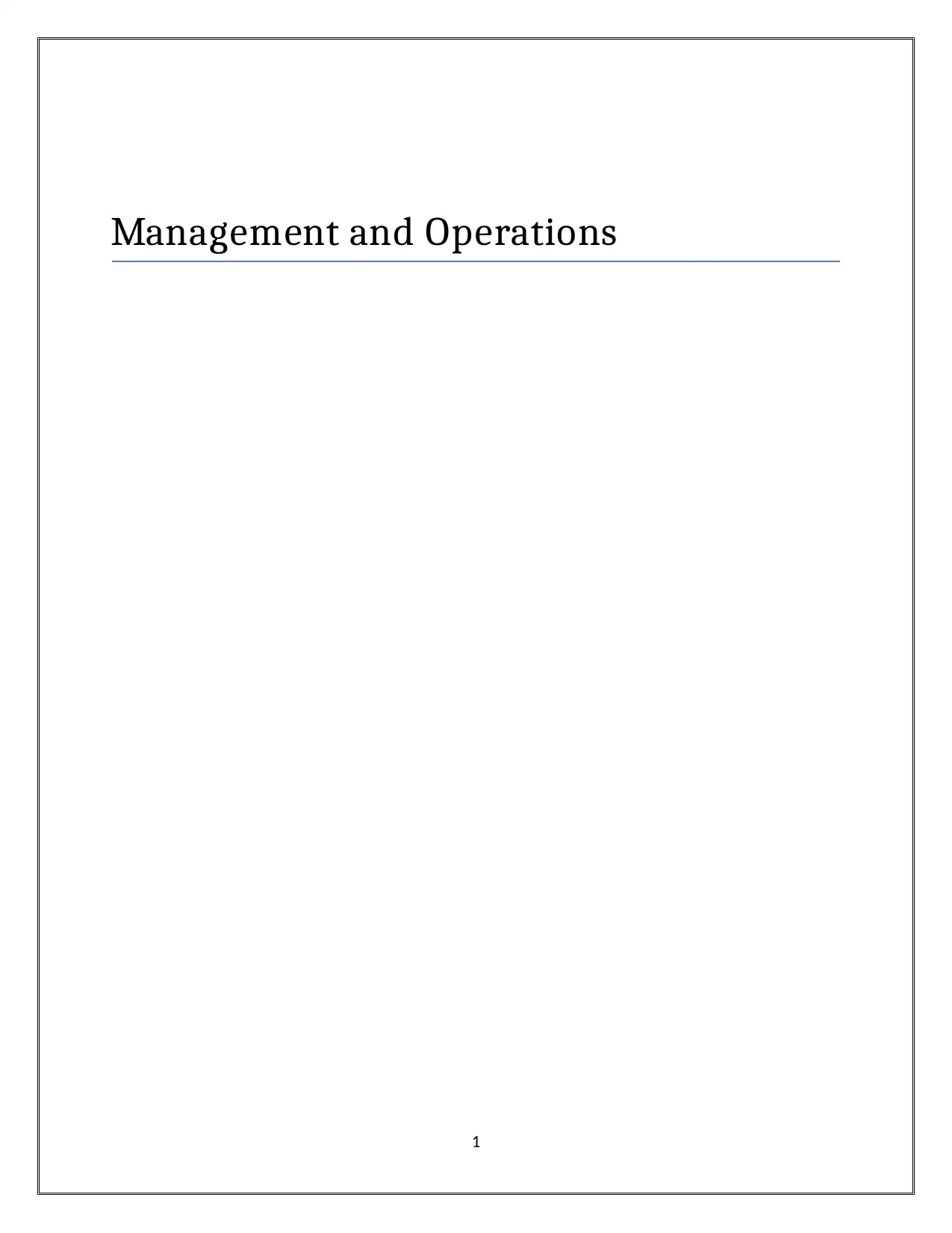
Management and Operations
1
1
Paraphrase This Document
Need a fresh take? Get an instant paraphrase of this document with our AI Paraphraser
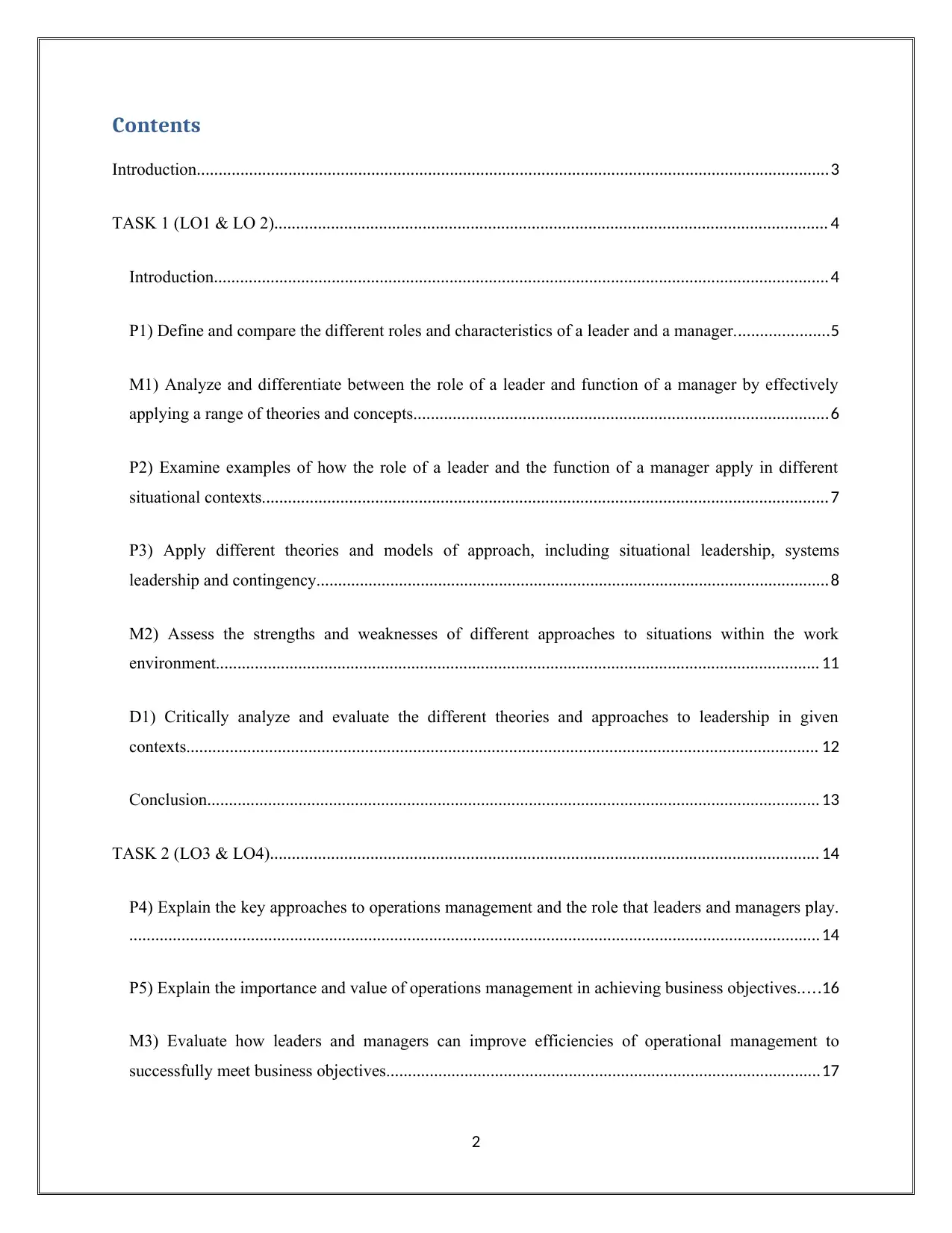
Contents
Introduction.................................................................................................................................................3
TASK 1 (LO1 & LO 2)............................................................................................................................... 4
Introduction............................................................................................................................................. 4
P1) Define and compare the different roles and characteristics of a leader and a manager......................5
M1) Analyze and differentiate between the role of a leader and function of a manager by effectively
applying a range of theories and concepts...............................................................................................6
P2) Examine examples of how the role of a leader and the function of a manager apply in different
situational contexts.................................................................................................................................. 7
P3) Apply different theories and models of approach, including situational leadership, systems
leadership and contingency......................................................................................................................8
M2) Assess the strengths and weaknesses of different approaches to situations within the work
environment........................................................................................................................................... 11
D1) Critically analyze and evaluate the different theories and approaches to leadership in given
contexts................................................................................................................................................. 12
Conclusion............................................................................................................................................. 13
TASK 2 (LO3 & LO4).............................................................................................................................. 14
P4) Explain the key approaches to operations management and the role that leaders and managers play.
............................................................................................................................................................... 14
P5) Explain the importance and value of operations management in achieving business objectives.....16
M3) Evaluate how leaders and managers can improve efficiencies of operational management to
successfully meet business objectives....................................................................................................17
2
Introduction.................................................................................................................................................3
TASK 1 (LO1 & LO 2)............................................................................................................................... 4
Introduction............................................................................................................................................. 4
P1) Define and compare the different roles and characteristics of a leader and a manager......................5
M1) Analyze and differentiate between the role of a leader and function of a manager by effectively
applying a range of theories and concepts...............................................................................................6
P2) Examine examples of how the role of a leader and the function of a manager apply in different
situational contexts.................................................................................................................................. 7
P3) Apply different theories and models of approach, including situational leadership, systems
leadership and contingency......................................................................................................................8
M2) Assess the strengths and weaknesses of different approaches to situations within the work
environment........................................................................................................................................... 11
D1) Critically analyze and evaluate the different theories and approaches to leadership in given
contexts................................................................................................................................................. 12
Conclusion............................................................................................................................................. 13
TASK 2 (LO3 & LO4).............................................................................................................................. 14
P4) Explain the key approaches to operations management and the role that leaders and managers play.
............................................................................................................................................................... 14
P5) Explain the importance and value of operations management in achieving business objectives.....16
M3) Evaluate how leaders and managers can improve efficiencies of operational management to
successfully meet business objectives....................................................................................................17
2
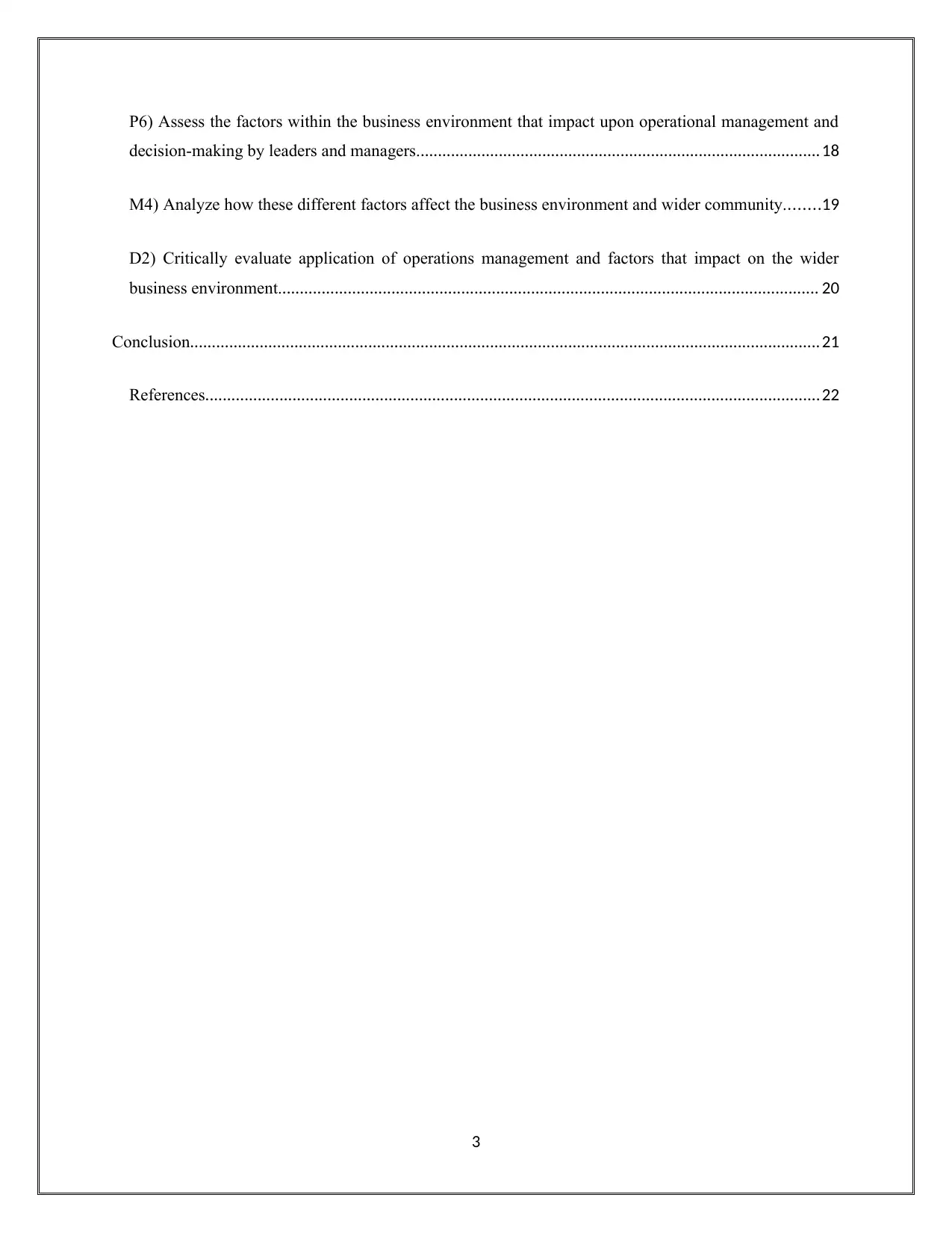
P6) Assess the factors within the business environment that impact upon operational management and
decision-making by leaders and managers............................................................................................. 18
M4) Analyze how these different factors affect the business environment and wider community........19
D2) Critically evaluate application of operations management and factors that impact on the wider
business environment............................................................................................................................ 20
Conclusion................................................................................................................................................. 21
References............................................................................................................................................. 22
3
decision-making by leaders and managers............................................................................................. 18
M4) Analyze how these different factors affect the business environment and wider community........19
D2) Critically evaluate application of operations management and factors that impact on the wider
business environment............................................................................................................................ 20
Conclusion................................................................................................................................................. 21
References............................................................................................................................................. 22
3
⊘ This is a preview!⊘
Do you want full access?
Subscribe today to unlock all pages.

Trusted by 1+ million students worldwide
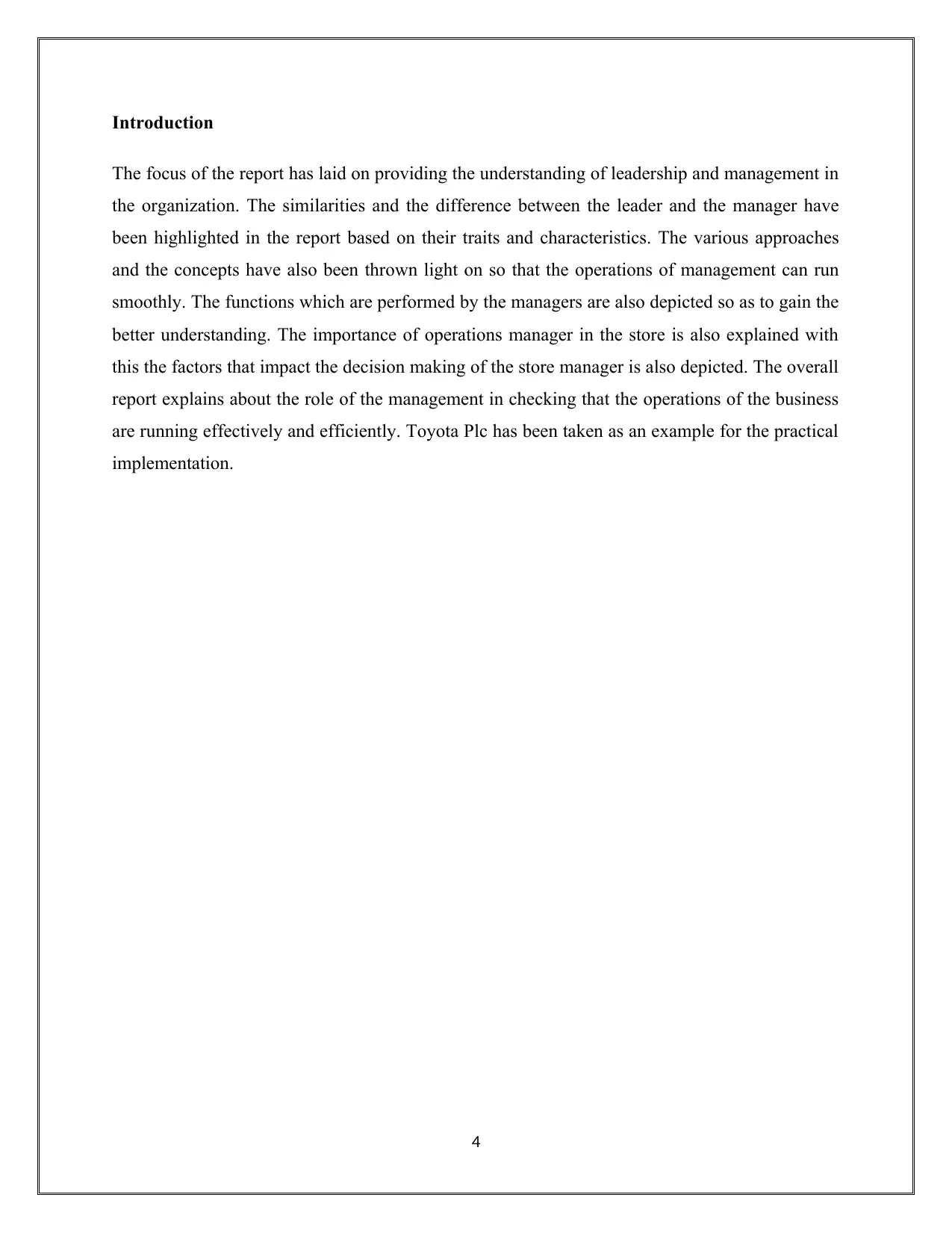
Introduction
The focus of the report has laid on providing the understanding of leadership and management in
the organization. The similarities and the difference between the leader and the manager have
been highlighted in the report based on their traits and characteristics. The various approaches
and the concepts have also been thrown light on so that the operations of management can run
smoothly. The functions which are performed by the managers are also depicted so as to gain the
better understanding. The importance of operations manager in the store is also explained with
this the factors that impact the decision making of the store manager is also depicted. The overall
report explains about the role of the management in checking that the operations of the business
are running effectively and efficiently. Toyota Plc has been taken as an example for the practical
implementation.
4
The focus of the report has laid on providing the understanding of leadership and management in
the organization. The similarities and the difference between the leader and the manager have
been highlighted in the report based on their traits and characteristics. The various approaches
and the concepts have also been thrown light on so that the operations of management can run
smoothly. The functions which are performed by the managers are also depicted so as to gain the
better understanding. The importance of operations manager in the store is also explained with
this the factors that impact the decision making of the store manager is also depicted. The overall
report explains about the role of the management in checking that the operations of the business
are running effectively and efficiently. Toyota Plc has been taken as an example for the practical
implementation.
4
Paraphrase This Document
Need a fresh take? Get an instant paraphrase of this document with our AI Paraphraser
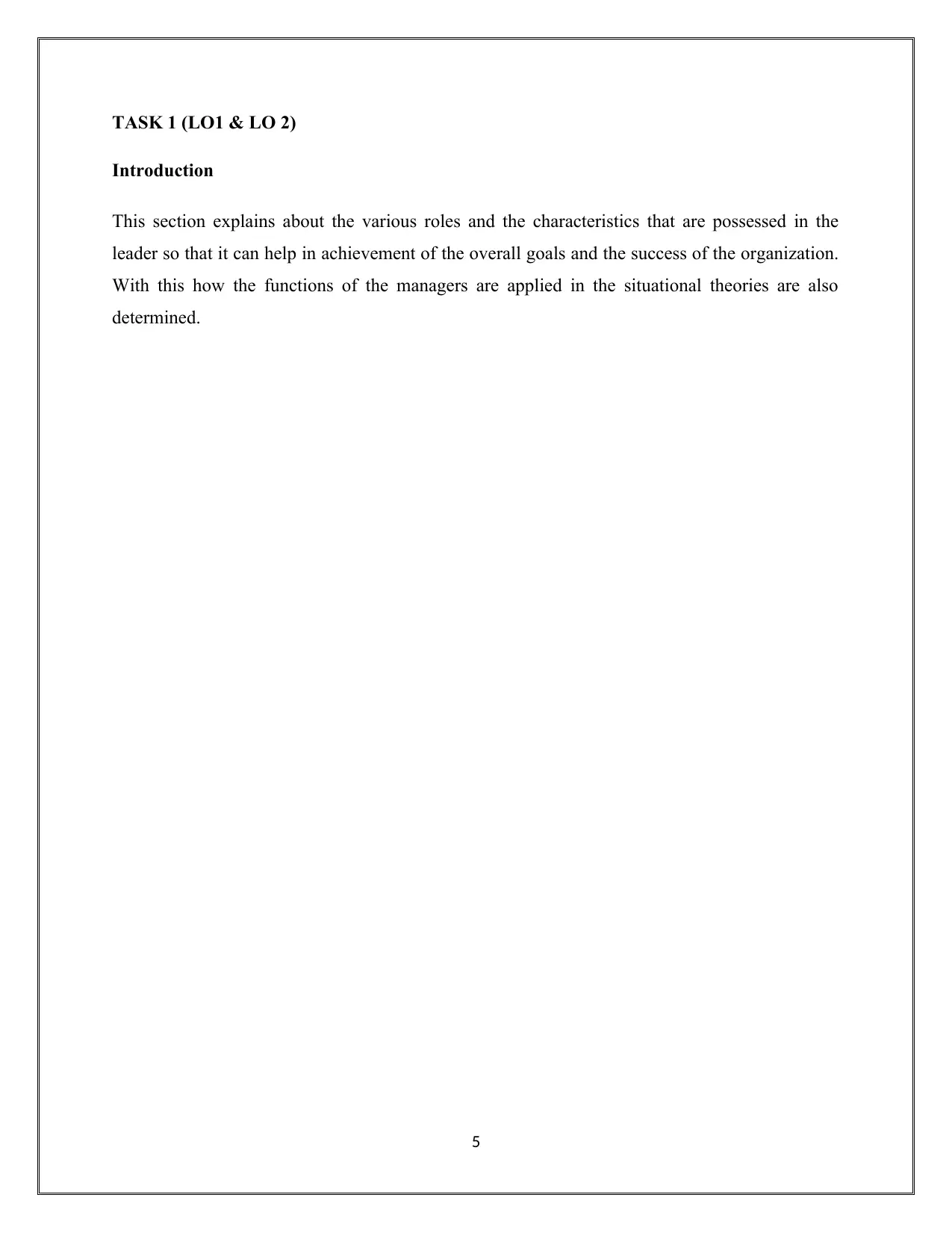
TASK 1 (LO1 & LO 2)
Introduction
This section explains about the various roles and the characteristics that are possessed in the
leader so that it can help in achievement of the overall goals and the success of the organization.
With this how the functions of the managers are applied in the situational theories are also
determined.
5
Introduction
This section explains about the various roles and the characteristics that are possessed in the
leader so that it can help in achievement of the overall goals and the success of the organization.
With this how the functions of the managers are applied in the situational theories are also
determined.
5
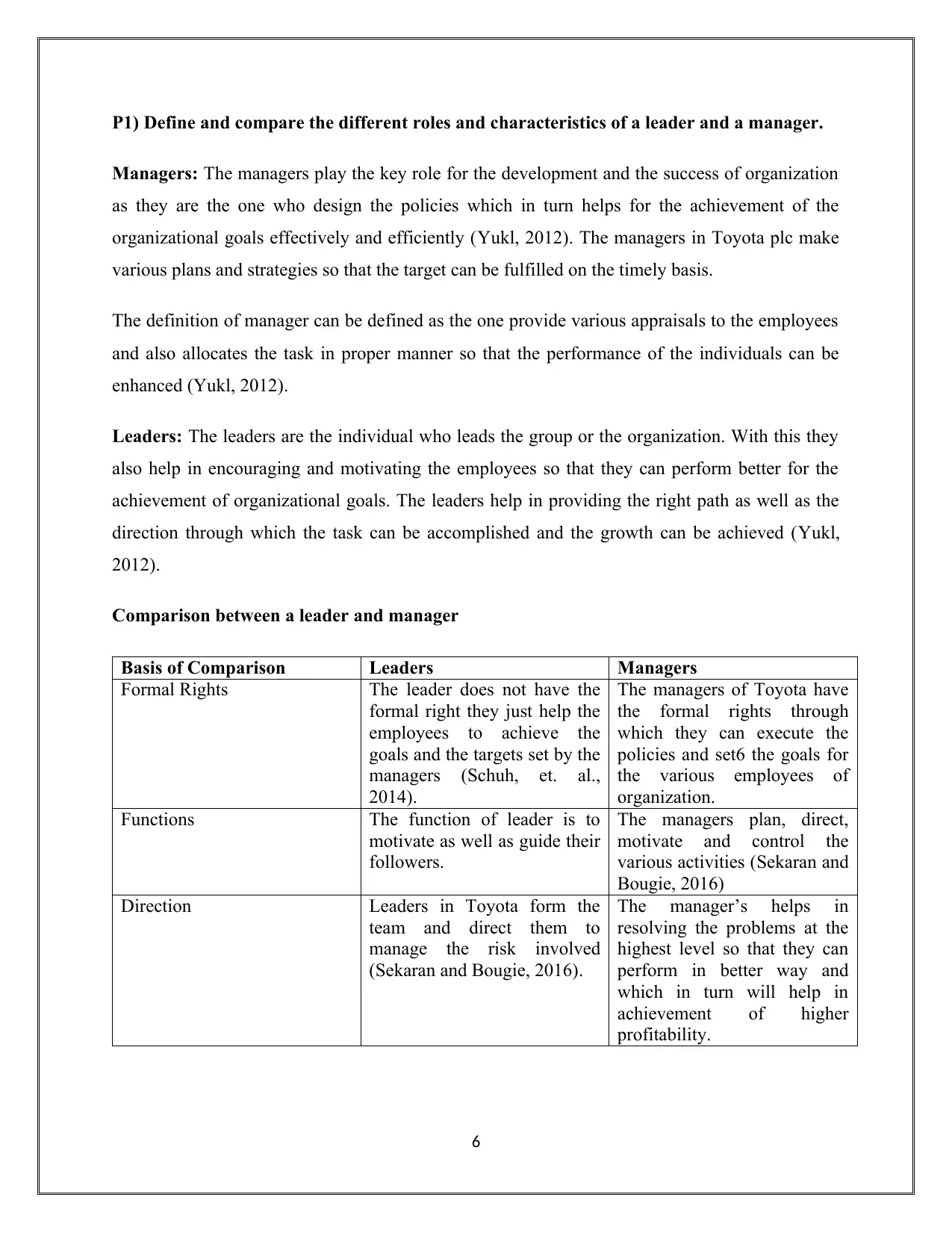
P1) Define and compare the different roles and characteristics of a leader and a manager.
Managers: The managers play the key role for the development and the success of organization
as they are the one who design the policies which in turn helps for the achievement of the
organizational goals effectively and efficiently (Yukl, 2012). The managers in Toyota plc make
various plans and strategies so that the target can be fulfilled on the timely basis.
The definition of manager can be defined as the one provide various appraisals to the employees
and also allocates the task in proper manner so that the performance of the individuals can be
enhanced (Yukl, 2012).
Leaders: The leaders are the individual who leads the group or the organization. With this they
also help in encouraging and motivating the employees so that they can perform better for the
achievement of organizational goals. The leaders help in providing the right path as well as the
direction through which the task can be accomplished and the growth can be achieved (Yukl,
2012).
Comparison between a leader and manager
Basis of Comparison Leaders Managers
Formal Rights The leader does not have the
formal right they just help the
employees to achieve the
goals and the targets set by the
managers (Schuh, et. al.,
2014).
The managers of Toyota have
the formal rights through
which they can execute the
policies and set6 the goals for
the various employees of
organization.
Functions The function of leader is to
motivate as well as guide their
followers.
The managers plan, direct,
motivate and control the
various activities (Sekaran and
Bougie, 2016)
Direction Leaders in Toyota form the
team and direct them to
manage the risk involved
(Sekaran and Bougie, 2016).
The manager’s helps in
resolving the problems at the
highest level so that they can
perform in better way and
which in turn will help in
achievement of higher
profitability.
6
Managers: The managers play the key role for the development and the success of organization
as they are the one who design the policies which in turn helps for the achievement of the
organizational goals effectively and efficiently (Yukl, 2012). The managers in Toyota plc make
various plans and strategies so that the target can be fulfilled on the timely basis.
The definition of manager can be defined as the one provide various appraisals to the employees
and also allocates the task in proper manner so that the performance of the individuals can be
enhanced (Yukl, 2012).
Leaders: The leaders are the individual who leads the group or the organization. With this they
also help in encouraging and motivating the employees so that they can perform better for the
achievement of organizational goals. The leaders help in providing the right path as well as the
direction through which the task can be accomplished and the growth can be achieved (Yukl,
2012).
Comparison between a leader and manager
Basis of Comparison Leaders Managers
Formal Rights The leader does not have the
formal right they just help the
employees to achieve the
goals and the targets set by the
managers (Schuh, et. al.,
2014).
The managers of Toyota have
the formal rights through
which they can execute the
policies and set6 the goals for
the various employees of
organization.
Functions The function of leader is to
motivate as well as guide their
followers.
The managers plan, direct,
motivate and control the
various activities (Sekaran and
Bougie, 2016)
Direction Leaders in Toyota form the
team and direct them to
manage the risk involved
(Sekaran and Bougie, 2016).
The manager’s helps in
resolving the problems at the
highest level so that they can
perform in better way and
which in turn will help in
achievement of higher
profitability.
6
⊘ This is a preview!⊘
Do you want full access?
Subscribe today to unlock all pages.

Trusted by 1+ million students worldwide
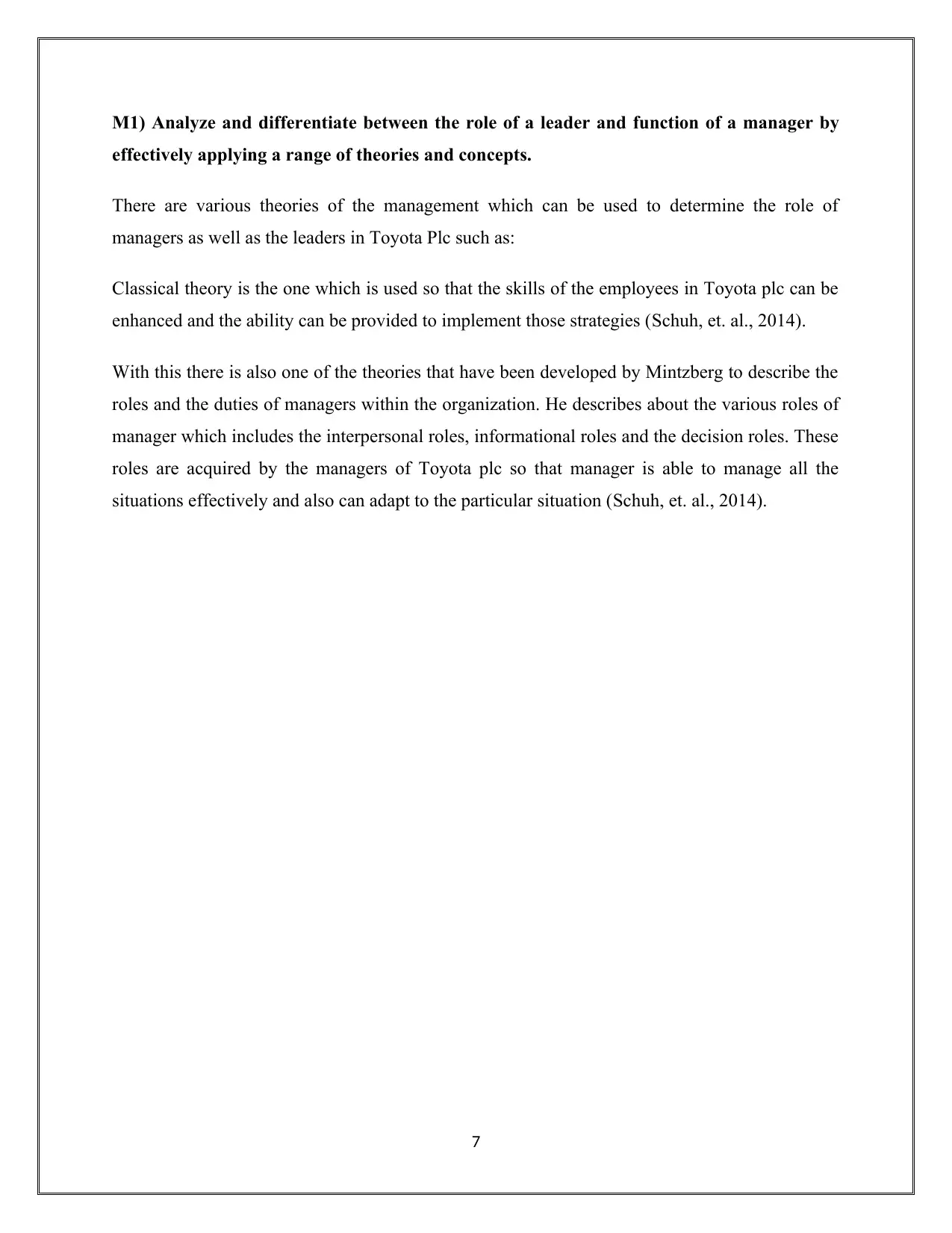
M1) Analyze and differentiate between the role of a leader and function of a manager by
effectively applying a range of theories and concepts.
There are various theories of the management which can be used to determine the role of
managers as well as the leaders in Toyota Plc such as:
Classical theory is the one which is used so that the skills of the employees in Toyota plc can be
enhanced and the ability can be provided to implement those strategies (Schuh, et. al., 2014).
With this there is also one of the theories that have been developed by Mintzberg to describe the
roles and the duties of managers within the organization. He describes about the various roles of
manager which includes the interpersonal roles, informational roles and the decision roles. These
roles are acquired by the managers of Toyota plc so that manager is able to manage all the
situations effectively and also can adapt to the particular situation (Schuh, et. al., 2014).
7
effectively applying a range of theories and concepts.
There are various theories of the management which can be used to determine the role of
managers as well as the leaders in Toyota Plc such as:
Classical theory is the one which is used so that the skills of the employees in Toyota plc can be
enhanced and the ability can be provided to implement those strategies (Schuh, et. al., 2014).
With this there is also one of the theories that have been developed by Mintzberg to describe the
roles and the duties of managers within the organization. He describes about the various roles of
manager which includes the interpersonal roles, informational roles and the decision roles. These
roles are acquired by the managers of Toyota plc so that manager is able to manage all the
situations effectively and also can adapt to the particular situation (Schuh, et. al., 2014).
7
Paraphrase This Document
Need a fresh take? Get an instant paraphrase of this document with our AI Paraphraser
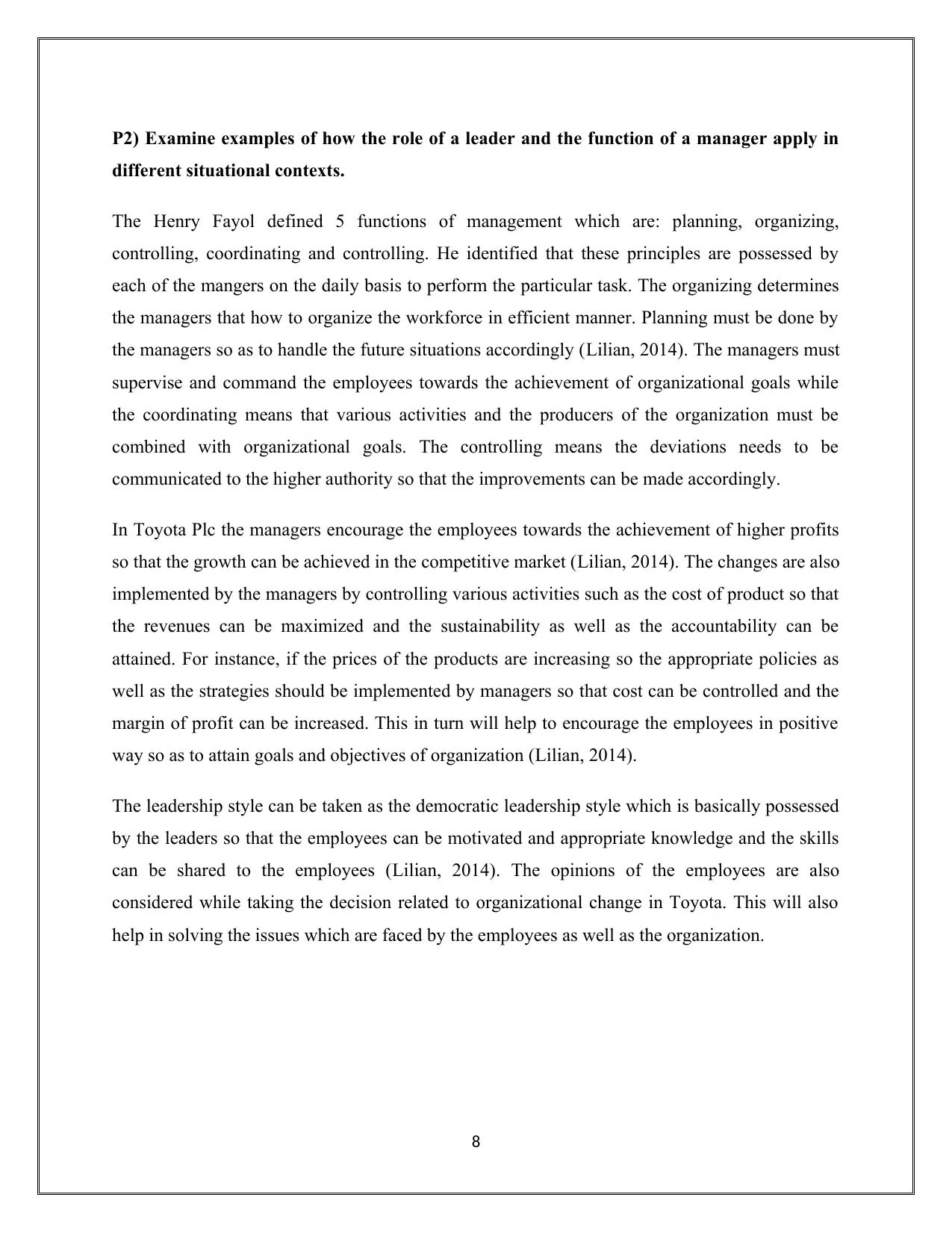
P2) Examine examples of how the role of a leader and the function of a manager apply in
different situational contexts.
The Henry Fayol defined 5 functions of management which are: planning, organizing,
controlling, coordinating and controlling. He identified that these principles are possessed by
each of the mangers on the daily basis to perform the particular task. The organizing determines
the managers that how to organize the workforce in efficient manner. Planning must be done by
the managers so as to handle the future situations accordingly (Lilian, 2014). The managers must
supervise and command the employees towards the achievement of organizational goals while
the coordinating means that various activities and the producers of the organization must be
combined with organizational goals. The controlling means the deviations needs to be
communicated to the higher authority so that the improvements can be made accordingly.
In Toyota Plc the managers encourage the employees towards the achievement of higher profits
so that the growth can be achieved in the competitive market (Lilian, 2014). The changes are also
implemented by the managers by controlling various activities such as the cost of product so that
the revenues can be maximized and the sustainability as well as the accountability can be
attained. For instance, if the prices of the products are increasing so the appropriate policies as
well as the strategies should be implemented by managers so that cost can be controlled and the
margin of profit can be increased. This in turn will help to encourage the employees in positive
way so as to attain goals and objectives of organization (Lilian, 2014).
The leadership style can be taken as the democratic leadership style which is basically possessed
by the leaders so that the employees can be motivated and appropriate knowledge and the skills
can be shared to the employees (Lilian, 2014). The opinions of the employees are also
considered while taking the decision related to organizational change in Toyota. This will also
help in solving the issues which are faced by the employees as well as the organization.
8
different situational contexts.
The Henry Fayol defined 5 functions of management which are: planning, organizing,
controlling, coordinating and controlling. He identified that these principles are possessed by
each of the mangers on the daily basis to perform the particular task. The organizing determines
the managers that how to organize the workforce in efficient manner. Planning must be done by
the managers so as to handle the future situations accordingly (Lilian, 2014). The managers must
supervise and command the employees towards the achievement of organizational goals while
the coordinating means that various activities and the producers of the organization must be
combined with organizational goals. The controlling means the deviations needs to be
communicated to the higher authority so that the improvements can be made accordingly.
In Toyota Plc the managers encourage the employees towards the achievement of higher profits
so that the growth can be achieved in the competitive market (Lilian, 2014). The changes are also
implemented by the managers by controlling various activities such as the cost of product so that
the revenues can be maximized and the sustainability as well as the accountability can be
attained. For instance, if the prices of the products are increasing so the appropriate policies as
well as the strategies should be implemented by managers so that cost can be controlled and the
margin of profit can be increased. This in turn will help to encourage the employees in positive
way so as to attain goals and objectives of organization (Lilian, 2014).
The leadership style can be taken as the democratic leadership style which is basically possessed
by the leaders so that the employees can be motivated and appropriate knowledge and the skills
can be shared to the employees (Lilian, 2014). The opinions of the employees are also
considered while taking the decision related to organizational change in Toyota. This will also
help in solving the issues which are faced by the employees as well as the organization.
8
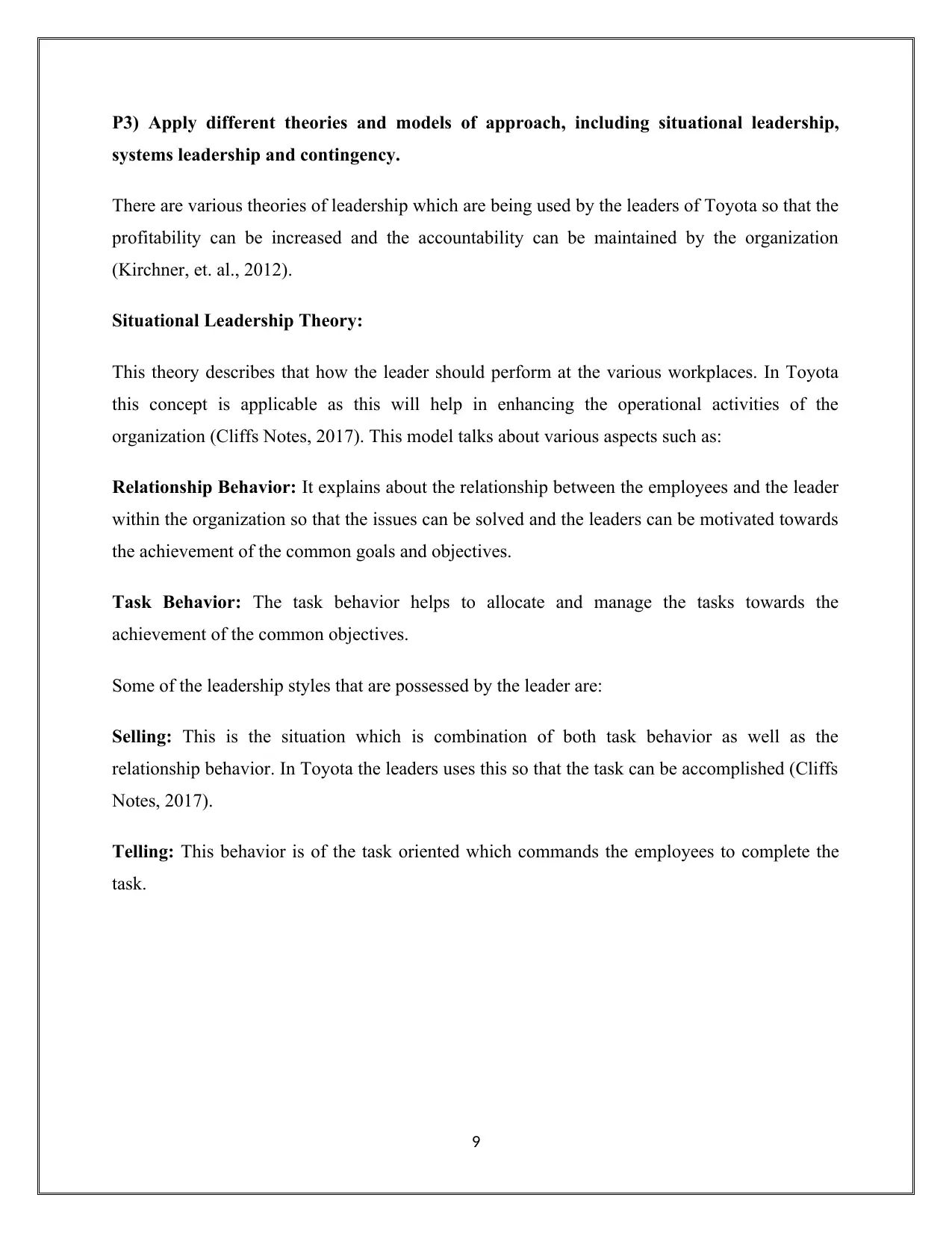
P3) Apply different theories and models of approach, including situational leadership,
systems leadership and contingency.
There are various theories of leadership which are being used by the leaders of Toyota so that the
profitability can be increased and the accountability can be maintained by the organization
(Kirchner, et. al., 2012).
Situational Leadership Theory:
This theory describes that how the leader should perform at the various workplaces. In Toyota
this concept is applicable as this will help in enhancing the operational activities of the
organization (Cliffs Notes, 2017). This model talks about various aspects such as:
Relationship Behavior: It explains about the relationship between the employees and the leader
within the organization so that the issues can be solved and the leaders can be motivated towards
the achievement of the common goals and objectives.
Task Behavior: The task behavior helps to allocate and manage the tasks towards the
achievement of the common objectives.
Some of the leadership styles that are possessed by the leader are:
Selling: This is the situation which is combination of both task behavior as well as the
relationship behavior. In Toyota the leaders uses this so that the task can be accomplished (Cliffs
Notes, 2017).
Telling: This behavior is of the task oriented which commands the employees to complete the
task.
9
systems leadership and contingency.
There are various theories of leadership which are being used by the leaders of Toyota so that the
profitability can be increased and the accountability can be maintained by the organization
(Kirchner, et. al., 2012).
Situational Leadership Theory:
This theory describes that how the leader should perform at the various workplaces. In Toyota
this concept is applicable as this will help in enhancing the operational activities of the
organization (Cliffs Notes, 2017). This model talks about various aspects such as:
Relationship Behavior: It explains about the relationship between the employees and the leader
within the organization so that the issues can be solved and the leaders can be motivated towards
the achievement of the common goals and objectives.
Task Behavior: The task behavior helps to allocate and manage the tasks towards the
achievement of the common objectives.
Some of the leadership styles that are possessed by the leader are:
Selling: This is the situation which is combination of both task behavior as well as the
relationship behavior. In Toyota the leaders uses this so that the task can be accomplished (Cliffs
Notes, 2017).
Telling: This behavior is of the task oriented which commands the employees to complete the
task.
9
⊘ This is a preview!⊘
Do you want full access?
Subscribe today to unlock all pages.

Trusted by 1+ million students worldwide
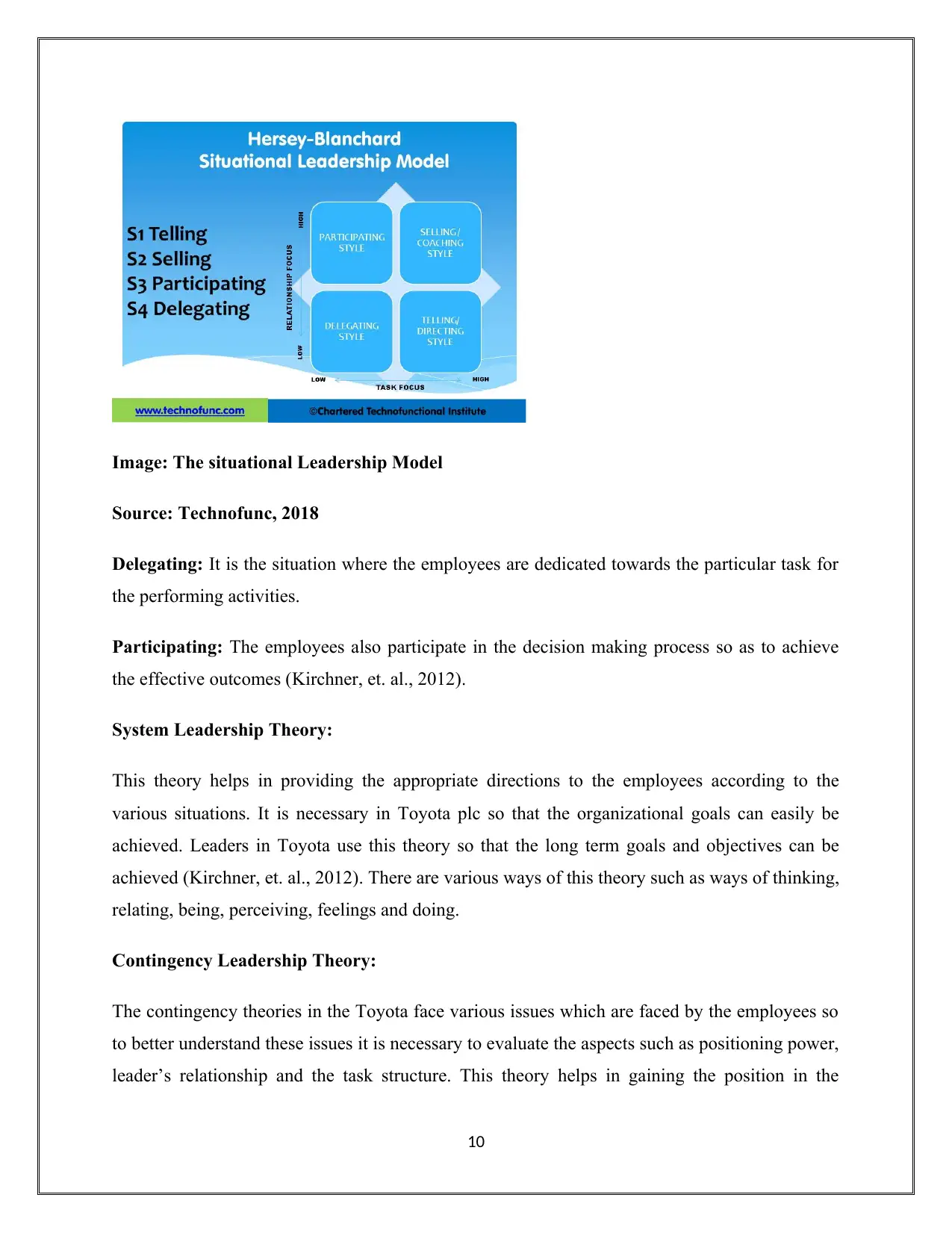
Image: The situational Leadership Model
Source: Technofunc, 2018
Delegating: It is the situation where the employees are dedicated towards the particular task for
the performing activities.
Participating: The employees also participate in the decision making process so as to achieve
the effective outcomes (Kirchner, et. al., 2012).
System Leadership Theory:
This theory helps in providing the appropriate directions to the employees according to the
various situations. It is necessary in Toyota plc so that the organizational goals can easily be
achieved. Leaders in Toyota use this theory so that the long term goals and objectives can be
achieved (Kirchner, et. al., 2012). There are various ways of this theory such as ways of thinking,
relating, being, perceiving, feelings and doing.
Contingency Leadership Theory:
The contingency theories in the Toyota face various issues which are faced by the employees so
to better understand these issues it is necessary to evaluate the aspects such as positioning power,
leader’s relationship and the task structure. This theory helps in gaining the position in the
10
Source: Technofunc, 2018
Delegating: It is the situation where the employees are dedicated towards the particular task for
the performing activities.
Participating: The employees also participate in the decision making process so as to achieve
the effective outcomes (Kirchner, et. al., 2012).
System Leadership Theory:
This theory helps in providing the appropriate directions to the employees according to the
various situations. It is necessary in Toyota plc so that the organizational goals can easily be
achieved. Leaders in Toyota use this theory so that the long term goals and objectives can be
achieved (Kirchner, et. al., 2012). There are various ways of this theory such as ways of thinking,
relating, being, perceiving, feelings and doing.
Contingency Leadership Theory:
The contingency theories in the Toyota face various issues which are faced by the employees so
to better understand these issues it is necessary to evaluate the aspects such as positioning power,
leader’s relationship and the task structure. This theory helps in gaining the position in the
10
Paraphrase This Document
Need a fresh take? Get an instant paraphrase of this document with our AI Paraphraser
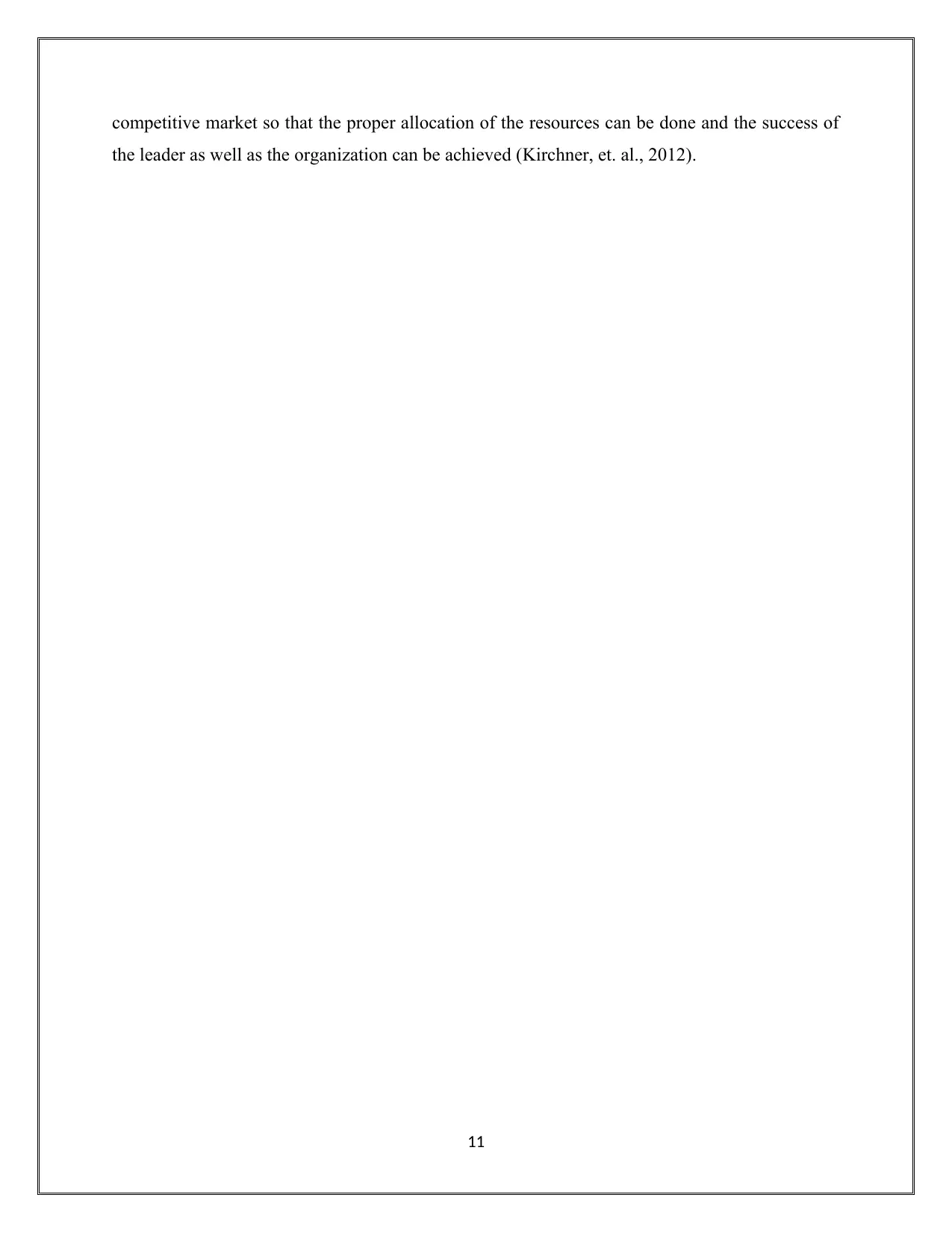
competitive market so that the proper allocation of the resources can be done and the success of
the leader as well as the organization can be achieved (Kirchner, et. al., 2012).
11
the leader as well as the organization can be achieved (Kirchner, et. al., 2012).
11
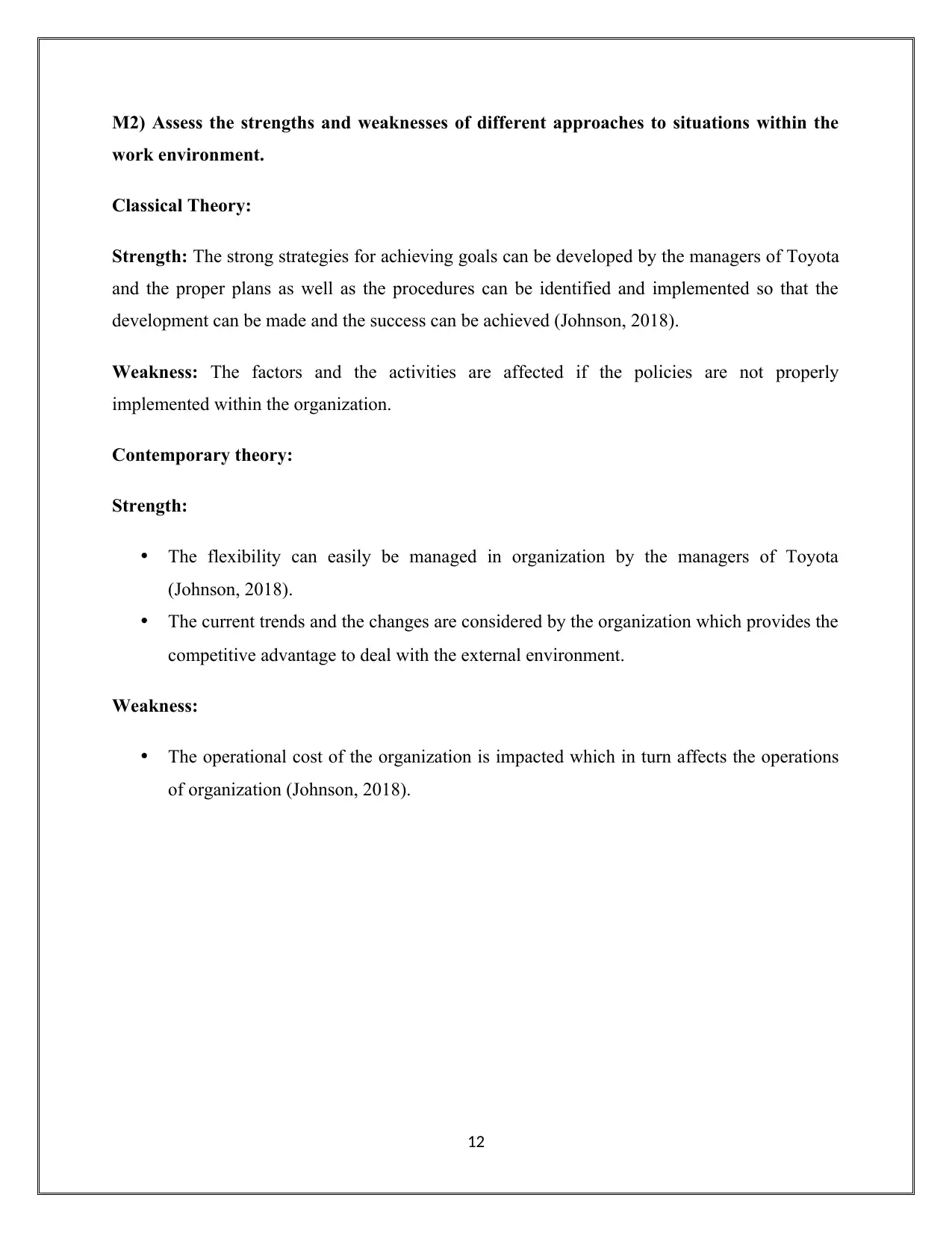
M2) Assess the strengths and weaknesses of different approaches to situations within the
work environment.
Classical Theory:
Strength: The strong strategies for achieving goals can be developed by the managers of Toyota
and the proper plans as well as the procedures can be identified and implemented so that the
development can be made and the success can be achieved (Johnson, 2018).
Weakness: The factors and the activities are affected if the policies are not properly
implemented within the organization.
Contemporary theory:
Strength:
The flexibility can easily be managed in organization by the managers of Toyota
(Johnson, 2018).
The current trends and the changes are considered by the organization which provides the
competitive advantage to deal with the external environment.
Weakness:
The operational cost of the organization is impacted which in turn affects the operations
of organization (Johnson, 2018).
12
work environment.
Classical Theory:
Strength: The strong strategies for achieving goals can be developed by the managers of Toyota
and the proper plans as well as the procedures can be identified and implemented so that the
development can be made and the success can be achieved (Johnson, 2018).
Weakness: The factors and the activities are affected if the policies are not properly
implemented within the organization.
Contemporary theory:
Strength:
The flexibility can easily be managed in organization by the managers of Toyota
(Johnson, 2018).
The current trends and the changes are considered by the organization which provides the
competitive advantage to deal with the external environment.
Weakness:
The operational cost of the organization is impacted which in turn affects the operations
of organization (Johnson, 2018).
12
⊘ This is a preview!⊘
Do you want full access?
Subscribe today to unlock all pages.

Trusted by 1+ million students worldwide
1 out of 24
Related Documents
Your All-in-One AI-Powered Toolkit for Academic Success.
+13062052269
info@desklib.com
Available 24*7 on WhatsApp / Email
![[object Object]](/_next/static/media/star-bottom.7253800d.svg)
Unlock your academic potential
Copyright © 2020–2025 A2Z Services. All Rights Reserved. Developed and managed by ZUCOL.





